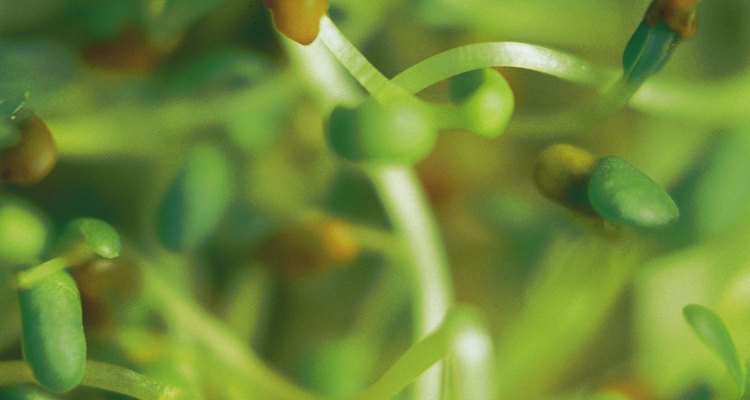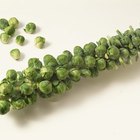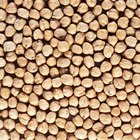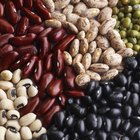
Comstock/Stockbyte/Getty Images
The most common objection leveled at sprouts is that they have a bitter taste, a trait that is easily avoided and far from characteristic of the sprout community as a whole. Bursting with vitamins, minerals and fiber and typically high in protein, sprouts can be harvested from the early germination phase of beans, peas and even cruciferous vegetables such as broccoli. When fresh, they can be consumed raw, and add a peppery crunch to a salad, or freshen up a protein-heavy sandwich. Freshness, sprout variety and hard-to-forget childhood preferences all influence bitterness.
The Worst Offenders
While most fresh sprouts have a barely perceptible bitterness and even give a light, sweet flavor, a few varieties carry stronger traces of bitterness than others. Fenugreek sprouts, in particular, have a take-it-or-leave-it bitterness which plays a significant role in Indian cooking through its aromatic properties, but which many people find overwhelming. A legume rather than a bean, Fenugreek is a more potent counterpart of another bitter sprout, the mung bean. Consumed fresh, mung beans are crunchy and sweet, but quickly take on a subtly bitter aftertaste within a few days, or if canned.
Poor Beginnings
Many people avoid sprouts because of a negative perception established during childhood. Crucially, though, the taste buds of the young are more receptive and more hostile to bitterness. As we age, our ability to deal with bitter flavors develops, and we even enjoy the experience, a phenomenon most commonly seen with beer consumption. One of the best ways to encourage children to tackle sprouts is by getting them to grow their own. Not only will it teach them about seed germination, but it will also tempt them to assume culinary ownership of the final product.
Simple Science
Most plants, herbs and vegetables contain phytonutrients which protect the flora against natural predators, but may also contribute to the bitter taste. While these chemicals have beneficial anti-carcinogenic properties, they are essentially toxins. The best known example is Brussels sprouts, which contain powerful but bitter alkaloids. The good news is that approximately 25 percent of people are unable to distinguish the bitter flavor of sprouts -- as well as cabbage, broccoli and dark beer -- due to a variation in a single gene which affects taste receptors on the tongue.
Surefire Solutions
The simple secret to dealing with the bitterness in Brussels sprouts is to completely remove the ends where the sprouts were joined to their stalk, along with any leaves attached to it. Slow roasting the sprouts with salt and oil will fully release their sweetness. For bean sprouts, you can try eating the sprout when the root shoot is still short, around the length of the soaked seed. In addition, be careful to discard any husks when rinsing, as these contribute to bitterness, particularly with mung beans.
Related Articles

How to Blanch Bitter Greens for Italian ...

How to Blanch Okra

Should You Steam or Blanch Bean Sprouts ...

Why Are My Collard Greens Bitter?

How to Store Alfalfa Sprouts

How to Cook Brussel Sprout Greens

The Difference Between Dried Peas and ...

Beans Vs. Lentils

Maine Wild Edible Plants

How to Know When Sprouted Garbanzo ...

How to Cook Broad Bean Shells
Can You Eat Chicory Raw?

How to Reduce the Bitterness of Escarole

How to Cook Tomatillos for Chili Verde

Are Pickled Vegetables Allowed on a Raw ...

Signs of a Jaded, Bitter Person

How to Cook Purple Hull Peas in the ...

How to Remove a Cardamom Seed From a Pod

Difference Between Soba and Udon Noodles

The Hippocrates Diet
References
- 23 and Me: Bitter Taste Perception
- Daily Mail: How Hating Sprouts and Broccoli Could Keep You Healthy
- The Cook's Thesaurus: Sprouts
- Fannetastic Food: How to Make Brussel Sprouts Delicious
- Now I Know: Sprouted
- Enjoy How to Cook: How to Cook Brussel Sprouts
- Asian online recipes: Bean Sprouts
- Sprout People: Fenugreek
- Living Foods: Sprouting Questions and Answers
Writer Bio
Nick Marshall is a UK-based writer specializing in trends and best-practice in the B2B sector.
Photo Credits
Comstock/Stockbyte/Getty Images